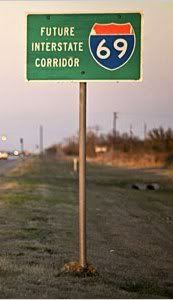I also keep thinking about what else could be done with $152 billion which might have a more lasting impact. Forget starting another war; $152 billion doesn't seem to go very far when the Pentagon is handling things. We're already up to about $200 billion for 2007-2008 and if we don't pull the plug on it soon, we're talking numbers in the trillions. A trillion is a thousand billion if I recall.
What $152 billion would do is pay for at least 75% of the Trans-Texas Corridor. Unfortunately the cost of nearly $200 billion is being put up by private investors and the bulk of it will be toll-roads.

There's also the controversial Interstate 69, or "NAFTA highway" as some call it, stretching from Mexico to Canada, and passing the northern edge of my hometown coincidentally -- an area not exactly blessed with easy freeway access.
For all the potential drawbacks, I'm quite certain a freeway in that area would be beneficial for bringing new jobs which are sorely needed. Where there's an exit, there are gas stations, restaurants, and maybe a motel or two. And such an important freeway could potentially attract industry along the route.
In an article from 2006, the cost for the 185-mile Arkansas portion was reported to be $1.7 billion with the cost for the entire corridor estimated at $17 billion.
Even throwing in a few extra billion for inflation or cost overruns, it seems to me that the $153 billion stimulus package could do a lot of good for our nation, just using new highways as an example.
Prefer public transit? Since 1971, Amtrak has received over $40 billion.
Here in Austin, Capital Metro has projected a cost of $1.9 billion for a 52 mile light-rail system. Granted, there are many who feel that number is unrealistic. Even if it ended up cost $3 billion, that's less than 2% of the cost of the economic stimulus package. And for those of you who are familiar with Austin traffic, such a rail system could be a great benefit to our city.
In Dallas, they are building a 21-mile project in addition to existing rail options, with a $700 million grant from the Federal Transit Administration. Gee, that's less than ONE billion dollars.
Earlier, a study released in May 2007 by the University of North Texas Center for Economic Development and Research projected that DART’s existing and soon-to-be-expanded LRT system will stimulate more than $8 billion in economic activity.
I could keep going with this but I think you get the idea. It's fun to see what we could do with $152 billion. Now imagine if we had all that money back from Iraq.

No comments:
Post a Comment